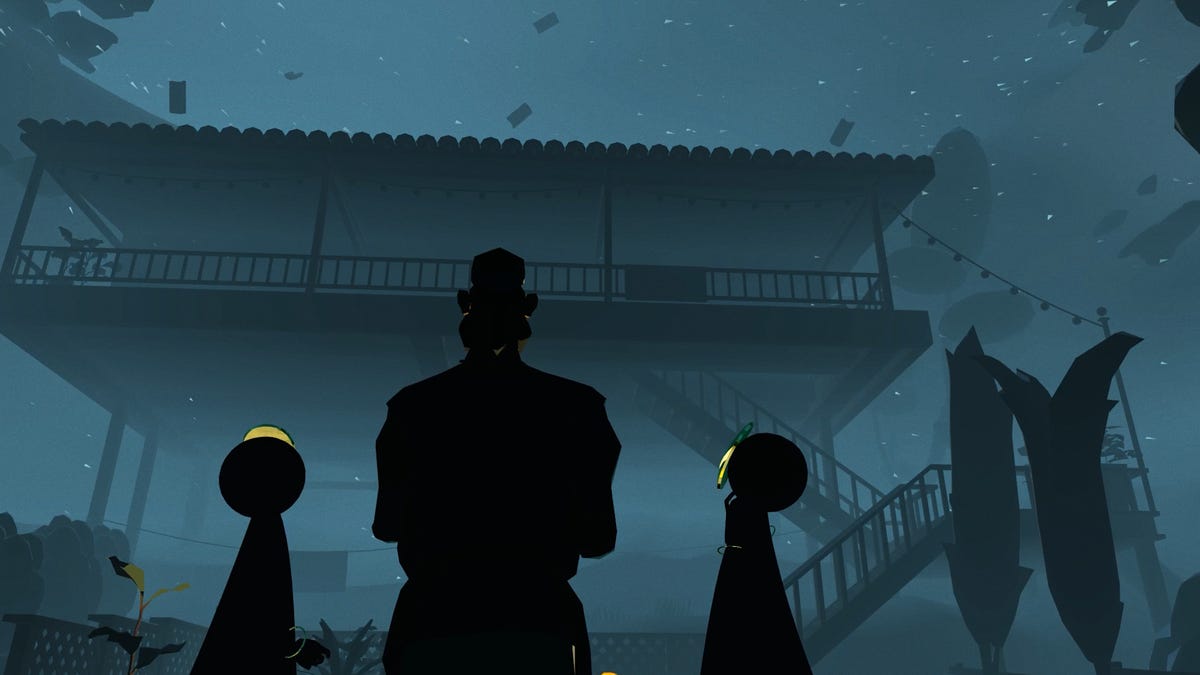The Tempest in VR: Ticketed theater is heading to headsets
The latest experiment from Oculus and Tender Claws is immersive theater for the stuck-at-home set.

An early moment from Tempest, a theater experience completely in VR.
In the desert, a single theater stands. There's a big sign: THE TEMPEST. Tickets are available. I pass the box office and enter the lobby. There's an empty bar and abandoned snacks. Crabs crawl on some piles of sand. And slowly, my fellow audience members arrive. We're all silent, masked ghosts. And then the lobby disappears and our show begins.
I'm suddenly standing in front of an old house in the Hollywood hills, where a man in front of a campfire tells us how he, an actor, was going to perform in The Tempest before the coronavirus pandemic struck. Now he's going to cast us to take part in the show.
I'm taking part in a 40-minute immersive theater production of Tempest in VR, produced by Oculus and Tender Claws, within the gaming-slash-theater app The Under Presents. The $15 ticketed performances have just begun for the latest experiment in our stay-at-home world: Trying to find a home for live theater in virtual reality and even in augmented reality.
I join in by way of an Oculus Quest headset in my home office. I don't know who my fellow theatergoers are and where they've come from, because in the world of The Under Presents, no player can speak, and no one has a face. Except, that is, for the one actor performing with us, telling us his tale.
I've spent hours in The Under Presents, where live actors are hired to perform in a gaming world along with home players. Now that actors are still mostly unable to participate in theater as it once existed before the pandemic, Oculus and Tender Claws are experimenting with live ticketed shows as a way to find more opportunities for actors.
The Under Presents: Tempest isn't normal Shakespeare: It's a loose and interactive interpretation. The three other audience members I'm with can search for items, wander around, nod and wave hands and silently emote. (Performances start July 9 and will be performed for groups of six to eight audience members, randomly assigned to different performing actors.) We're like a VR Greek chorus, in a way, evoking reality while the actor playing Prospero choreographs and guides us. It's immersive theater and it expects audience members to be a part of the show.
A few months ago, I was asked to play a virtual chorus member in another VR theater project called Pandora X. The feeling of being a masked participant was similar. In virtual worlds where we're free to wander, what does it mean to be an audience member? How much can we interact? And how much can we control?
Approaching the box office.
The world of Tempest is all bright colors and flat shapes, like a 3D cartoon. This is what The Under Presents' app feels like too. The art style and tone remind me of the also-theatrical indie game, Kentucky Route Zero. Virtual reality can't do human faces easily, and instead of trying, this production makes everything look like cartoon avatars. The effect largely works, but it also makes the experience feel, at times, like a video game. Sometimes I need to remind myself that the performer in front of me is a real, live person, a real actor somewhere else (Terence Leclere, one of 11 actors working on the production, whose real face I can't see, but I can hear and see embodied in a burly actor avatar).
I've tried VR escape rooms that bring four people together with a VR actor host, and this is a similar idea. Think of the host as a type of dungeon master that can summon objects, transport the players to new locations or weave a story together. We became the pieces that made his tale a reality.
The audience plays roles, but can't speak.
I was cast as a captain of a ship at one point. I helped celebrate a wedding in another. I was under the ocean, watching a giant spirit speak. I nodded my head and waved my arms a lot. Being a silent participant was sometimes odd, and at other times I wanted to be more invisible, free to wander and watch with the detached feel I had in real-life immersive theater like Sleep No More or Then She Fell. Immersive theater is an experience of creative submission for me. Tempest gave me more direct interaction than that, but it's not designed to have me speak or improvisationally transform the show, either.
The $15 ticket feels more reasonable than the $25 to $100 prices I've seen for other online and virtual live games and performances, and it also gives you free access to the vast game world of The Under Presents. (Another multichapter experience in The Under, called Timeboat, is now being sold as an extra $12 add-on, changing up the price of the original app.) The length of Tempest is perfect, too. After too much time in VR at a stretch, I can get fidgety and tired.
At the end of our journey, we're given a souvenir of our experience. I won't share what it is, but it reminded me of similar immersive theater experiences I've had in real spaces: Getting an object or a letter to take home with me. The virtual memento felt important, somehow.
Tempest sometimes feels like a game. Sometimes it feels like theater. Sometimes it feels like a choreographed, ticketed, custom-build version of the multiplayer things already happening in social apps such as AltSpace VR and VRChat. It's experiments like this that I hope continue in VR: collaborative, artistic. It won't be the last.

